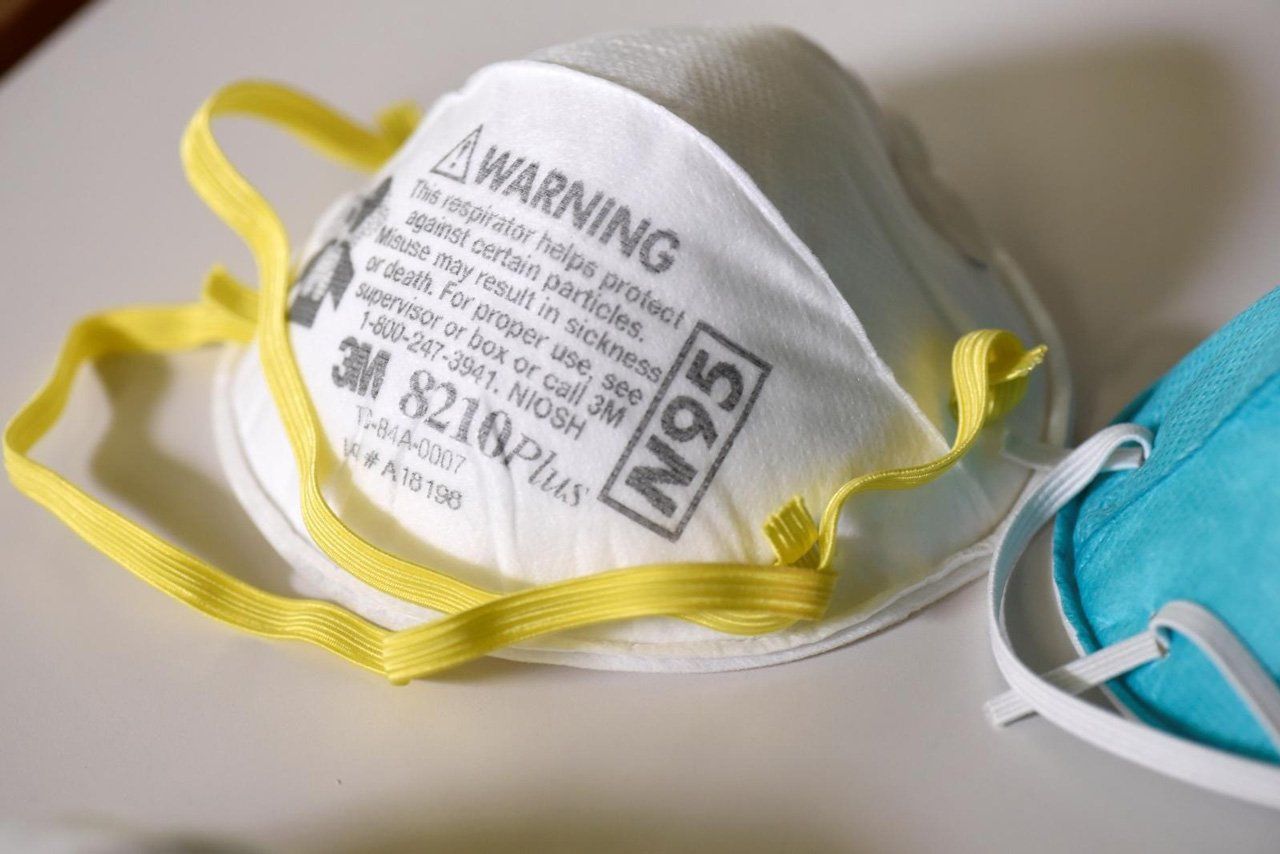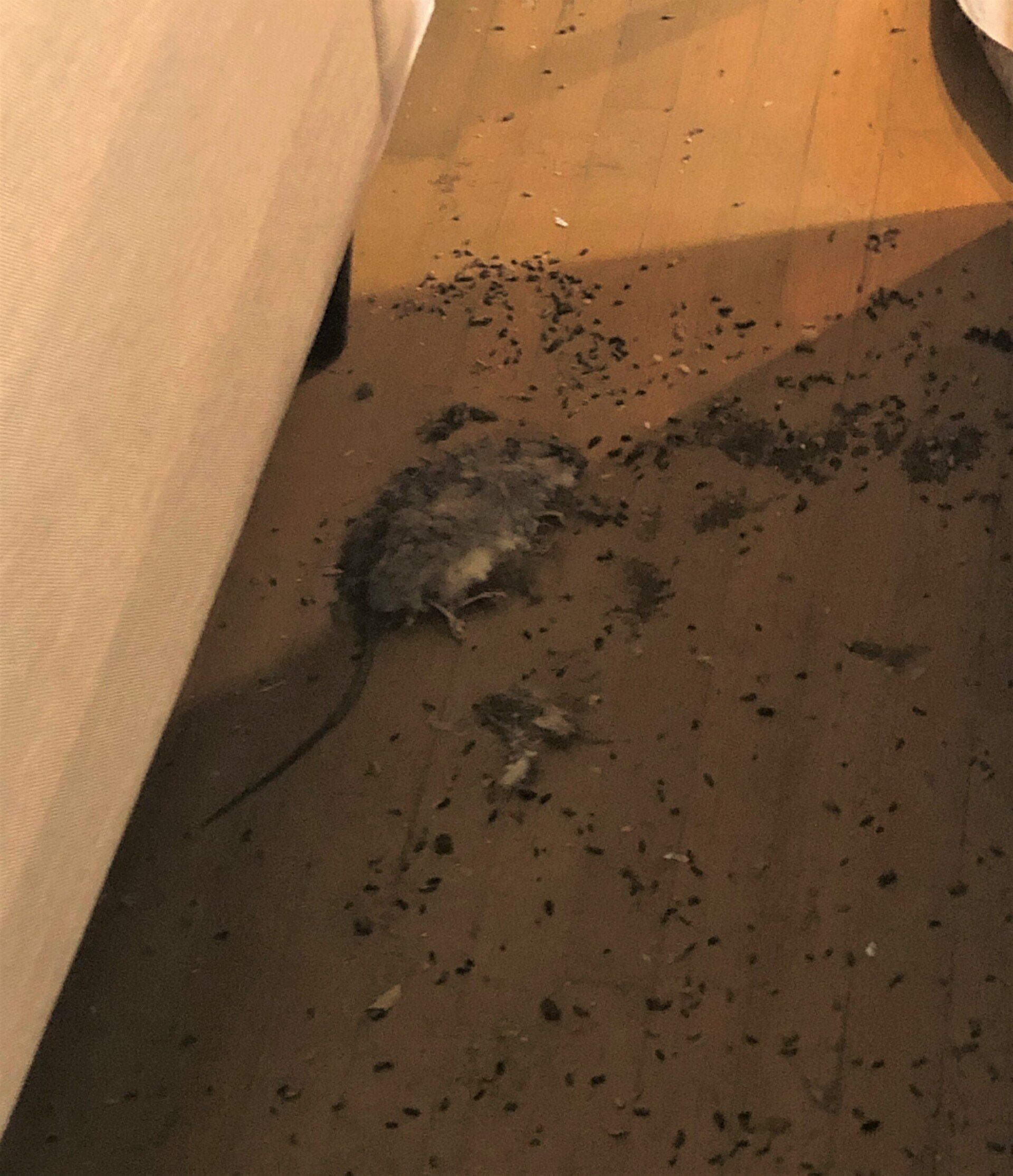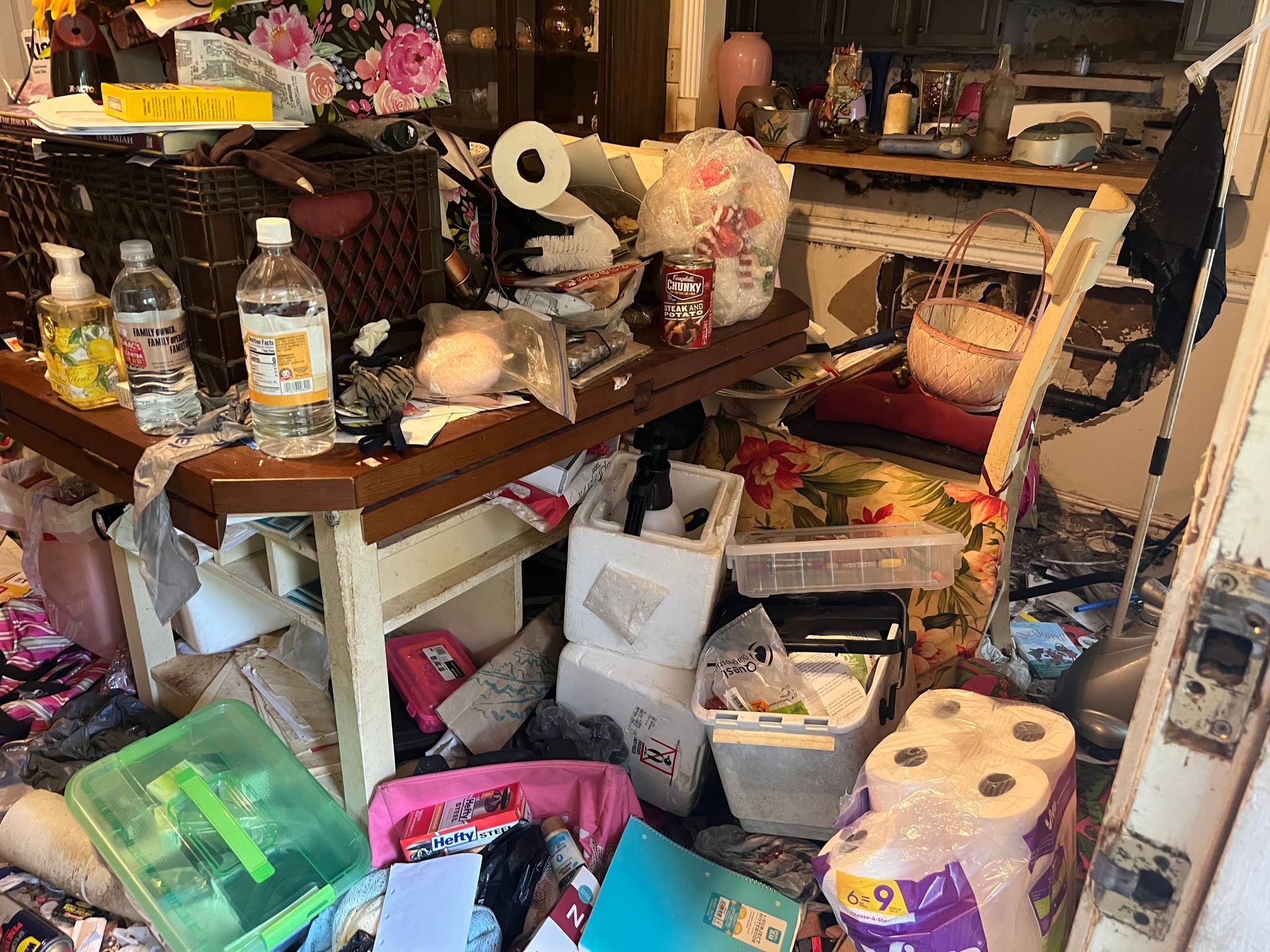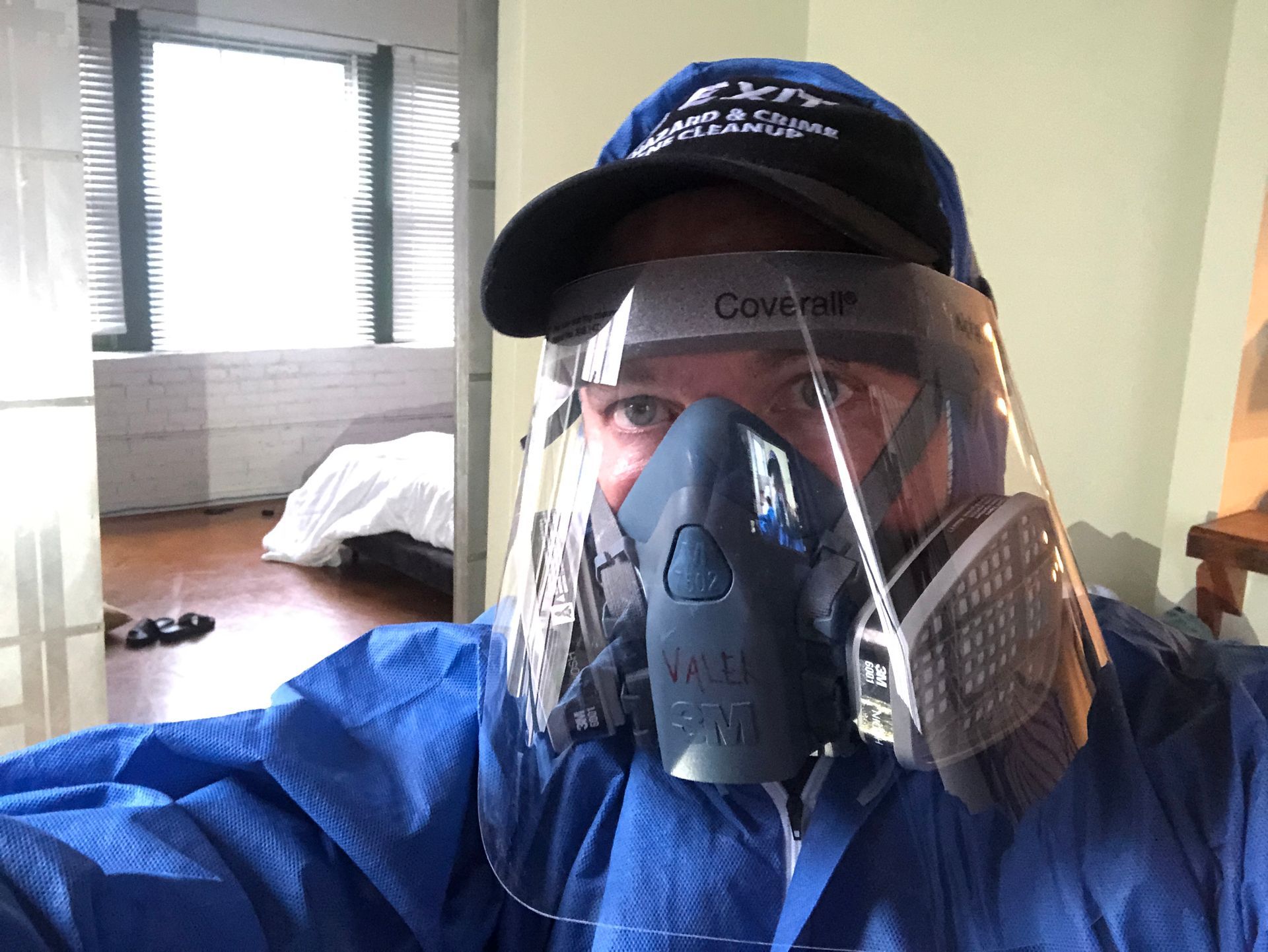Respirators, N95 Masks and Surgical masks, what’s the difference?
November 20, 2019

What is a respirator?
It’s a key piece of PPE ( Personal Protective Equipment ) for crime scene cleanup so we don’t breathe in any bloodborne pathogens . Some may find this fascinating and some may find this a boring read, but if you wanted to know all about n95 masks and respirators then read on. A respirator is a device designed to protect the wearer from inhaling hazardous or unpleasant atmospheres, including gases, fumes, vapors, and particulate matter such as dusts and airborne microorganisms like the coronavirus . You can imagine how a respirator designed for organic vapor which can keep out the odors from a decomposing body during a cleanup can come in handy. Its also keeping potentially dangerous viruses and bacteria from getting into the mouth nose and lungs. It’s truly a lifesaver.
There are two main categories of respirators: the air-purifying respirator types (APRs) , in which breathable air is obtained by filtering a contaminated atmosphere, and the air-supplied respirator (SARs) , in which an alternate supply of breathable air is delivered. Each type uses different techniques to reduce or eliminate noxious airborne contaminants.
Air-Purifying filtering Respirators range from relatively inexpensive single-use such as surgical masks and n95 disposable masks, or reusable respirator models with replaceable cartridges often called a gas mask or simply a respirator. These are easy to use and very portable and range from inexpensive to several hundreds of dollars. These are the most common of the two types because of cost, portability, and ease of use. We at Exit Cleanup use these daily when cleaning up blood and trauma scenes.
The Air Supplied Respirator is basically a clean supply of breathable air either from wearable tanks or air supplied from an outside source and brought in via hose to the wearer. Generally, these are much more complicated than the typical filtering type. These range from the air tanks you see firemen wear, This is a self-contained breathing apparatus, or SCBA, to the odd looking hose from the ceiling supplying clean air in a cleanroom or laboratory. These are usually more expensive systems and have more limitations such as range or weight than a typical n95 respirator. These supply air to the wearer so they can be used in more harsh environments such as oxygen poor atmospheres due to fire smoke or chemical hazards.
N95 Mask
With the Corona virus crisis , we have heard a lot about PPE and protective masks so when we talk about the N95 mask or respirator its because it’s the most common mask with a wide range of protection. Why do we call it an N95? The NIOSH N95 designation means that when subjected to careful testing, the respirator blocks at least 95 % of very small (0.3 micron) particles. The National Institute for Occupational Safety and Health, NIOSH , is the United States federal agency responsible for conducting research and making recommendations for the prevention of work-related injury and illness. NIOSH is part of the Centers for Disease Control and Prevention (CDC). The N95 respirator is the most common type of particulate filtering facepiece respirators. An N95 respirator is designed to achieve a very close facial fit and very efficient filtration of airborne particles. Note that the edges of the respirator are designed to form a seal around the nose and mouth. Surgical N95 Respirators are commonly used in healthcare settings and are a subset of N95 Filtering Facepiece Respirators (FFRs), often referred to as N95s. There are other respirators such as:
N95 – Filters at least 95% of airborne particles. Not resistant to oil.
Surgical N95 – A NIOSH-approved N95 respirator that has also been cleared by the Food and Drug Administration (FDA) as a surgical mask.
N99 – Filters at least 99% of airborne particles. Not resistant to oil.
N100 – Filters at least 99.97% of airborne particles. Not resistant to oil.
R95 – Filters at least 95% of airborne particles. Somewhat resistant to oil.
P95 – Filters at least 95% of airborne particles. Strongly resistant to oil.
P99 – Filters at least 99% of airborne particles. Strongly resistant to oil.
P100 – Filters at least 99.97% of airborne particles. Strongly resistant to oil.
Surgical Mask
Lastly the Surgical Mask , A surgical mask is a loose-fitting, disposable device that creates a physical barrier between the mouth and nose of the wearer and potential contaminants in the immediate environment. These are typically used in places that are highly disinfected already such as medical facilities. These are often referred to as face masks, although not all face masks are regulated as surgical masks. Note that the edges of the mask are not designed to form a seal around the nose and mouth.
The similarities among surgical masks and surgical N95s are: They are tested for fluid resistance, filtration efficiency (particulate filtration efficiency and bacterial filtration efficiency), flammability and biocompatibility.
They should not be shared or reused.
Protect yourself by wearing the proper respirators for the job at hand. Exit Biohazard an d Crime Scene Cleanup trains and uses several different styles of respirators and we follow the OSHA Respiratory Protection Standard to ensure safety for our employees and clients.
It’s a key piece of PPE ( Personal Protective Equipment ) for crime scene cleanup so we don’t breathe in any bloodborne pathogens . Some may find this fascinating and some may find this a boring read, but if you wanted to know all about n95 masks and respirators then read on. A respirator is a device designed to protect the wearer from inhaling hazardous or unpleasant atmospheres, including gases, fumes, vapors, and particulate matter such as dusts and airborne microorganisms like the coronavirus . You can imagine how a respirator designed for organic vapor which can keep out the odors from a decomposing body during a cleanup can come in handy. Its also keeping potentially dangerous viruses and bacteria from getting into the mouth nose and lungs. It’s truly a lifesaver.
There are two main categories of respirators: the air-purifying respirator types (APRs) , in which breathable air is obtained by filtering a contaminated atmosphere, and the air-supplied respirator (SARs) , in which an alternate supply of breathable air is delivered. Each type uses different techniques to reduce or eliminate noxious airborne contaminants.
Air-Purifying filtering Respirators range from relatively inexpensive single-use such as surgical masks and n95 disposable masks, or reusable respirator models with replaceable cartridges often called a gas mask or simply a respirator. These are easy to use and very portable and range from inexpensive to several hundreds of dollars. These are the most common of the two types because of cost, portability, and ease of use. We at Exit Cleanup use these daily when cleaning up blood and trauma scenes.
The Air Supplied Respirator is basically a clean supply of breathable air either from wearable tanks or air supplied from an outside source and brought in via hose to the wearer. Generally, these are much more complicated than the typical filtering type. These range from the air tanks you see firemen wear, This is a self-contained breathing apparatus, or SCBA, to the odd looking hose from the ceiling supplying clean air in a cleanroom or laboratory. These are usually more expensive systems and have more limitations such as range or weight than a typical n95 respirator. These supply air to the wearer so they can be used in more harsh environments such as oxygen poor atmospheres due to fire smoke or chemical hazards.
N95 Mask
With the Corona virus crisis , we have heard a lot about PPE and protective masks so when we talk about the N95 mask or respirator its because it’s the most common mask with a wide range of protection. Why do we call it an N95? The NIOSH N95 designation means that when subjected to careful testing, the respirator blocks at least 95 % of very small (0.3 micron) particles. The National Institute for Occupational Safety and Health, NIOSH , is the United States federal agency responsible for conducting research and making recommendations for the prevention of work-related injury and illness. NIOSH is part of the Centers for Disease Control and Prevention (CDC). The N95 respirator is the most common type of particulate filtering facepiece respirators. An N95 respirator is designed to achieve a very close facial fit and very efficient filtration of airborne particles. Note that the edges of the respirator are designed to form a seal around the nose and mouth. Surgical N95 Respirators are commonly used in healthcare settings and are a subset of N95 Filtering Facepiece Respirators (FFRs), often referred to as N95s. There are other respirators such as:
N95 – Filters at least 95% of airborne particles. Not resistant to oil.
Surgical N95 – A NIOSH-approved N95 respirator that has also been cleared by the Food and Drug Administration (FDA) as a surgical mask.
N99 – Filters at least 99% of airborne particles. Not resistant to oil.
N100 – Filters at least 99.97% of airborne particles. Not resistant to oil.
R95 – Filters at least 95% of airborne particles. Somewhat resistant to oil.
P95 – Filters at least 95% of airborne particles. Strongly resistant to oil.
P99 – Filters at least 99% of airborne particles. Strongly resistant to oil.
P100 – Filters at least 99.97% of airborne particles. Strongly resistant to oil.
Surgical Mask
Lastly the Surgical Mask , A surgical mask is a loose-fitting, disposable device that creates a physical barrier between the mouth and nose of the wearer and potential contaminants in the immediate environment. These are typically used in places that are highly disinfected already such as medical facilities. These are often referred to as face masks, although not all face masks are regulated as surgical masks. Note that the edges of the mask are not designed to form a seal around the nose and mouth.
The similarities among surgical masks and surgical N95s are: They are tested for fluid resistance, filtration efficiency (particulate filtration efficiency and bacterial filtration efficiency), flammability and biocompatibility.
They should not be shared or reused.
Protect yourself by wearing the proper respirators for the job at hand. Exit Biohazard an d Crime Scene Cleanup trains and uses several different styles of respirators and we follow the OSHA Respiratory Protection Standard to ensure safety for our employees and clients.

If you have a case of CDIFF and need help call EXIT BIOHAZARD CLEANUP and have us come and disinfect your home. What is CDIFF? C.diff stands for Clostridium difficile (klos-TRID-e-oi-deez dif-uh-SEEL), which is a germ or bacterium that causes a symptomatic infection due to the spore-forming bacterium, Clostridium difficile. It causes many Symptoms which include watery diarrhea, fever, nausea, and abdominal pain. It makes up about 20% of cases of antibiotic-associated diarrhea. It most commonly affects older adults in hospitals or in long-term care facilities. Complications may include pseudomembranous colitis, toxic megacolon, perforation of the colon, and sepsis which can be life threatening. One in 11 people over age 65 diagnosed with a healthcare-associated C. diff infection die within one month. In general it causes severe diarrhea and colitis (an inflammation of the colon). It’s estimated to cause almost half a million infections in the United States each year. C. diff can affect anyone. Most cases of C. diff occur when you’ve been taking antibiotics or not long after you’ve finished taking antibiotics. There are other risk factors such as being 65 or older, a recent stay at a hospital or nursing home, a weakened immune system, such as people with HIV/AIDS, cancer, or organ transplant patients taking immunosuppressive drugs, or previous infection with C. diff or known exposure to the germs. Because 1 in 6 patients who get C. diff will get it again in the subsequent 2-8 weeks . If you have been taking antibiotics recently and have symptoms of C. diff, you should see a healthcare professional as soon as possible. Getting diarrhea is fairly common while on, or after taking, antibiotics, but in only a few cases will that diarrhea be caused by C. diff . So if your diarrhea is severe you need to talk to your doctor and do not delay getting medical care. Your doctor will review your symptoms and order a lab test of a stool (poop) sample. If the test is positive, you’ll take a specific antibiotic (e.g. vancomycin or fidaxomicin) for at least 10 days. If you were already taking an antibiotic for another infection, your healthcare professional might ask you to stop taking it if they think it’s safe to do so. Your doctor may decide to admit you to the hospital, in which case they will use certain precautions, such as wearing gowns and gloves, to prevent the spread of C. diff to themselves and to other patients because it can be very contagious . its important to use a separate bathroom if you have diarrhea, thoroughly wash hands with soap and water every time you use the bathroom and always before you eat, and take showers washing well with soap. Cleanliness is key to beating this and stopping it from spreading to others or back to you. Because C.DIFF bacteria can last for months. When the bacteria are outside the human body they can be virtually anywhere in the environment. They are in a dormant state and essentially shutdown waiting for a new host. This enables them to survive for a long time from weeks to months in any number of places and that's why its very difficult to destroy and it is also why people often have the infection reoccur. The ability of it to be dormant and survive outside the body enables the generally easy transmission of the bacterium. It can last a long time sitting on surfaces, in soil or feces, in water areas, or even in food. Once the bacteria finds their way into a person's digestive system, they "wake up" and can begin to produce infection again. That being said, its not the easiest bacteria to kill. its not like covid which is pretty weak in the environment and generally dies quickly. this has some staying power and requires special cleaning and disinfection procedures. We often kill corona virus and other germs during our disinfection fogging services to help stop the spread of covid 19 and we kill 99.99% of germs and viruses in general for most of our services including our biohazard cleaning services, but CDIFF is something special and its much harder to kill so we have to bring out the big guns to do it. We mean specialty chemicals and procedures to kill what is there and what is hiding dormant. At Exit Cleanup we just think of this as another service we provide but as you can see its not your typical disinfection. If you have Cdiff or someone in your family does and you want us there to kill it, please just call and we will prepare for germ warfare for you. We will fight this for you.

This is to describe the 4 levels of biohazards and the 6 types of biohazards. Biohazard cleanup is important because we could encounter a biohazard anytime anywhere. Learn more here. A biohazard could be anything from animal feces or rancid meat to blood from a crime scene or materials from a laboratory.

A suicide in New Orleans. Exit cleanup doesn't always get the job but we do all we can to help in any situation. Most of the time, your home owners insurance pays the biohazard cleanup but if the deceased lived in an apartment, it may be something that the property owner may want to pay for. Its sometimes complicated but Exit will help. This situation was difficult because the resident committed suicide and the property owner wasn't available. Long story short , we helped out the sister of the deceased a bit so she could get things sorted and did what we could.












